Recent Posts
-
Real Crimes and the Coming Violence
September 6, 2025
-
Whither Modern Life?
June 27, 2025
-
What the Hell
June 18, 2025
-
As Darkness Engulfs Us
April 6, 2025
-
AI, Risk, and Work
January 17, 2025
-
“Things Are in the Saddle, and Ride Mankind”
December 29, 2024
-
Forgotten Futures in Seattle
December 12, 2024
-
Autocracy Defeats Neoliberalism
November 14, 2024
-
History… We’re Soaking in It!
October 2, 2024
-
A Numbing Spectacle
September 22, 2024
|
I just turned 56 on March 11, and find myself paying closer attention than ever to what kinds of things get remembered, forgotten, overlooked, and flushed from public consciousness.
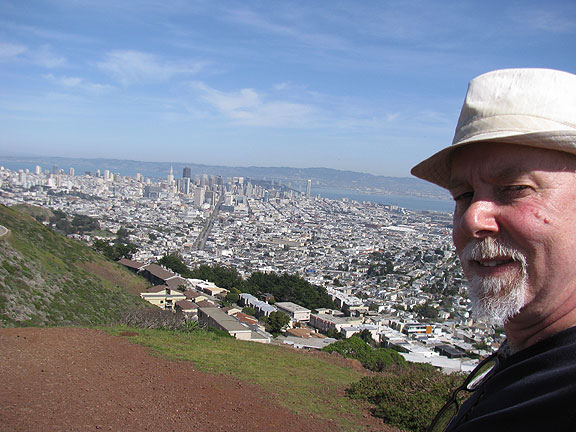 My telltale posture at the top of the City on a beautiful sunny March 11, when I turned 56.  Very nice of Twin Peaks to provide me with a gorgeous display of wildflowers to celebrate! Living through this period, with another jaw-dropping wave of evictions devastating my circle of friends and acquaintances throughout San Francisco, the displacement of long-time residents is one obvious example of historic phenomena that get systematically flushed from the public record. I went to a discussion about the recently passed Proposition C Housing Trust Fund at SPUR a couple of weeks ago and there was nary a mention about the eviction crisis. Other politicians are trying to throw gasoline on the fire by passing a special ordinance to allow 2,500 units of “tenancy in common” apartments gain immediate condominium status. If it passes without the multi-year moratorium on condo conversions demanded by tenant activists, the wave of evictions is sure to accelerate beyond its already frenzied pace.
I consider my own building’s fuse to have been lit with the commitment of our landlady to state conservatorship… it’s probably only a matter of time before we’re evicted too, but with luck, maybe we can last another 2 years, or even 10! And we’re going to make our best effort to set up a Community Land Trust option for this building, so that maybe, just maybe, we can figure out a way to stay in San Francisco.
It would be a pity to be evicted from the city after working on San Francisco history for nearly two decades. Back in the first Gulf War era I felt strongly the amnesiac culture when friends I’d marched alongside couldn’t remember that we’d been part of a large anti-war movement in 1990-91. Now we’re at the 10th anniversary of the Iraq War and the media is mostly still repeating the history-flushing lies they promulgated at the time—that no one knew that the government was deliberately lying to get us into war. Actually San Franciscans shut the city down because tens of thousands of us knew perfectly well the venal lies that were hurtling us down a barbaric path. A decade later we can say “we told you so,” but it’s an empty effort, gaining no traction or amplification, and thus practically invisible, probably forgotten even by many of us who were in the streets in March 2003.
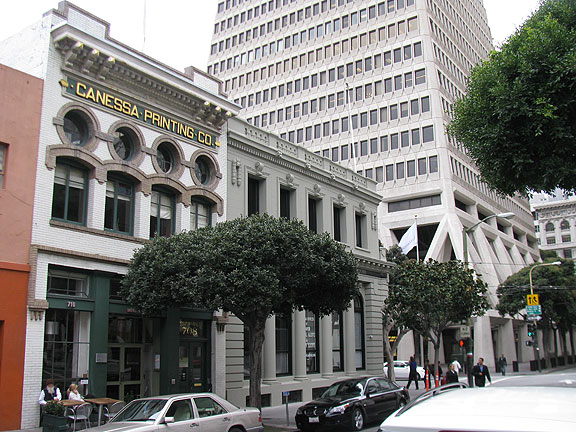 Canessa Gallery on Montgomery. I popped in to the charming Canessa Gallery on Montgomery Street (the site of the original Black Cat Café in the 1950s, home on the ground floor to Jose Sarria and the first open gay scene in the City) where the Living New Deal Project is hosting a modest exhibit of New Deal art, including these recently made posters about the Post Office. They’ve been campaigning to save the many post offices around California and the country that are getting privatized and closed, and losing their architectural and artist treasures in the process. They are also promoting the idea of a New Deal Museum in the Presidio, so if you’re someone who likes to comment on such proposals, it’s open at the Presidio to chime in with your support.
 One of the posters created for the new campaign to oppose the attacks on the Post Office. Continue reading Amnesia and History
Long time, no blog. Might’ve called this the Winter of my Discontent, but I don’t really want to get into the details of the past few months. Housing and income dramas are underway, with no particular end in sight, while various political and social groupings left me feeling isolated and disappointed. So it goes. And I just haven’t felt like writing. Photos in this post not related to what I’m writing about, but kind of a parallel story of high tides and beautiful winter light.
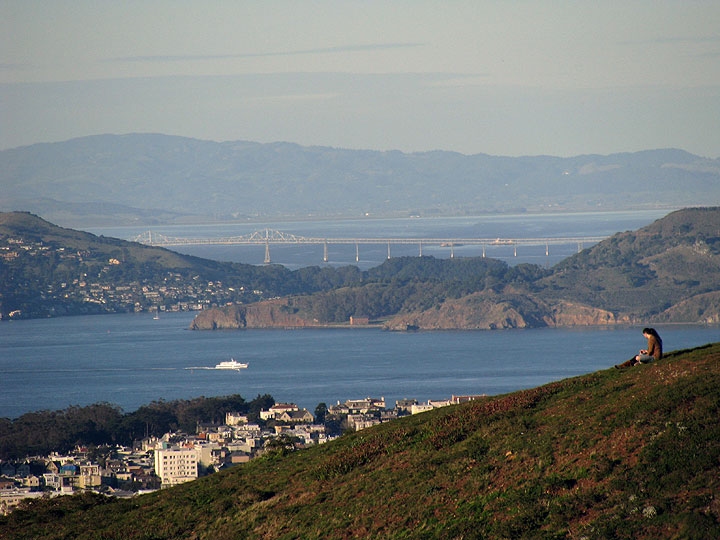 Early January view north from Twin Peaks (south). San Rafael bridge visible across the edge of Angel Island. I find myself staying up and getting up late (it was really bad during the holidaze), reading a lot, staying home instead of going out, reducing my internet time though not as much as I ought to. Never fails to amaze me how much time I can waste noodling around the internet, reading posts, news, catching up on this and that. I’m going to come back to this in a later post, but one cluster of books I read recently included Geert Lovink’s Networks Without a Cause which informed me that no one reads blogs, or if there are some readers, certainly no one comments on them (that has long been my experience—stats indicate that there are usually about 1000 visitors a month, but how many are real people? How many read anything through? And comments? Less than a dozen per year of non-spam, actual thoughtful commentaries.) I’ve always understood this blog, and my writing in general, to be in service to what I want to say. I don’t write for an audience. I appreciate it when people get something out of what I write, but I have never written FOR an audience, but for myself.
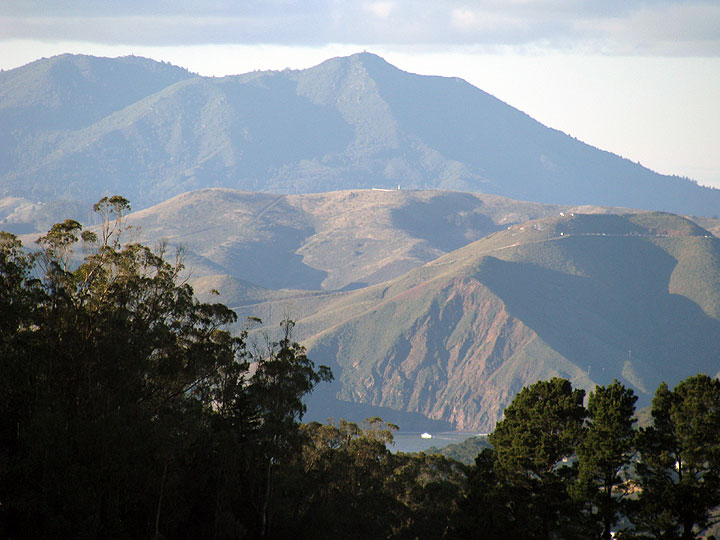 Surprising that a view like this is possible from the same spot on Twin Peaks. Anyway, I just started teaching 19th century San Francisco history at the SF Art Institute again, and decided I needed to get better informed about the first half of the 19th century that preceded the founding of San Francisco or the acquisition of California by the U.S. Some months ago I read about Andrew Jackson and his Indian Wars against the large cultures of the southeast (Creek, Cherokee, Seminole, Chocktaw, Chickasaw), pushing them west across the Mississippi during his Presidential reign 1828-1836. Even earlier than that I read about the Comanches and the empire they anchored in the southern Great Plains from the mid-18th century to after the Civil War, a story that is left out of most histories. Due to the severe pressure of Comanche raids on Texas, Mexico liberalized immigration to the territory, leading to an influx of Americans who became the majority of the population by the early 1830s. The Texans gained their independence from Mexico in 1836 and were an independent country for about nine years before annexation to the United States in 1845. But those years of independence involved huge debts incurred to British and U.S. banks, a floundering economy, and a persistent claim by Mexico that Texas was still part of it, while at the same time the Comanches continued their dominating economic role of raiding and trading all around and in Texan territory, making economic development along capitalist or even just large agrarian lines nearly impossible.
Amy Greenberg’s excellent history “A Wicked War: Polk, Clay, Lincoln, and the 1846 U.S. Invasion of Mexico” helped me grasp a lot of the missing pieces politically of the decade and a half before the beginning the city of San Francisco. Perhaps the most remarkable single item I learned was how the U.S. started the Mexican-American War. I had assumed it had to do with the gold discovery in California and that there had been some kind of pretext to allow the U.S. to attack. But I hadn’t realized that the pattern established in 1846 became the DNA of U.S. military expansionism and is still being followed to this day.
 California King Tide in January led to coastal flooding, a sign of things to come! Continue reading Old Patterns Still With Us
I went to Mexico City over Thanksgiving to visit my wife, who is hard at work on complicated project involving a penal reform initiative there. The photos scattered through this post are from my visit, but have little to do directly with what I’m writing about.
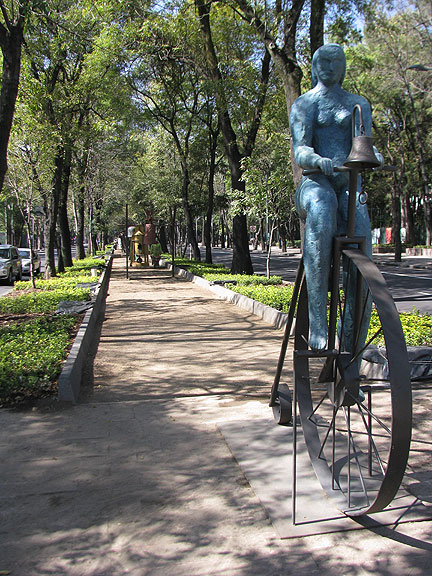 Penny-farthing riding woman in Chapultepec Park, Mexico City. I had lots of time to read and managed to whip through a couple of books while there, one about Andrew Jackson and his Indian Wars in the early 1800s (a grim story), and the other, Paul Mason’s remarkable and highly readable Why It’s Kicking Off Everywhere: The New Global Revolutions (Verso 2012). Mason’s book does a great job of putting the uprisings of 2011 in a longer-term historical context, as well as helping to emphasize that they are far from over (the past week’s new uprising in Egypt served as a loud exclamation point on this larger argument!). It complements in a fascinating way another short book I read the week before I left by Franco “Bifo” Berardi called The Uprising: On Poetry and Finance (Semiotext(e) Intervention Series No. 14). In fact, at one point Mason quotes Berardi from an essay he co-wrote with long-time cyber-theoretician Geert Lovink called “A Call to the Army of Love and to the Army of Software,” labeling Berardi as the “figurehead” of “autonomism,” and crediting it as the political theory that most influenced the exploding horizontalist social uprisings of the past year.
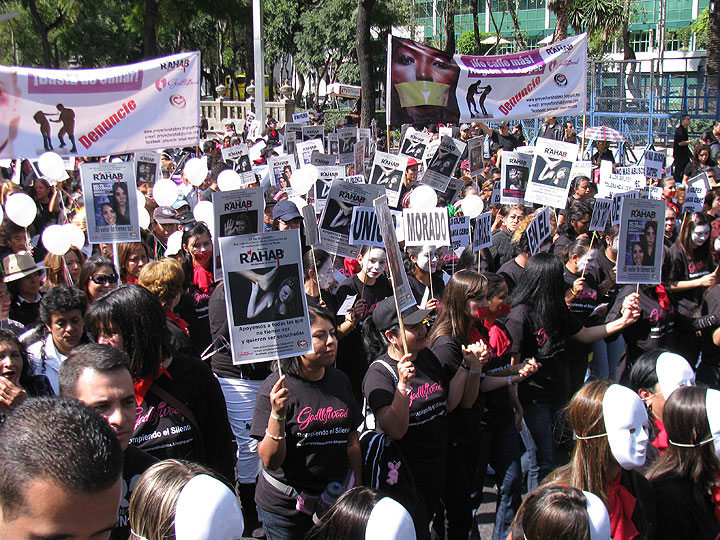 A large demo left from near our hotel on Saturday Nov. 24, part of the International Day Protesting Violence Against Women... it was probably 2000-3000 with people from all over Mexico City's neighborhoods represented. The Marxian concept of General Intellect has been inspiring to me for a while already. I wrote about it at length in Nowtopia, using the concept to contextualize the myriad ways people take their time and technological know-how out of market relations to begin producing a social and technological foundation for a post-capitalist life. The concept goes back to Karl Marx’s Grundrisse and “the Fragment on Machines” which has been heavily plumbed in the past couple of decades for its prescient analysis of the stage of capitalism we seem to be in now, more than a century after Marx first described it. The most commonly quoted piece of it is this: “The development of fixed capital indicates to what degree general social knowledge has become a direct force of production, and to what degree, hence, the conditions of the process of social life itself have come under the control of the general intellect and been transformed in accordance with it.”
Continue reading In the Trenches with General Intellect
|
Hidden San Francisco 2nd EDITION!

NEW 2nd EDITION NOW AVAILABLE!
Buy one here
(Pluto Press, Spring 2025)
|




















